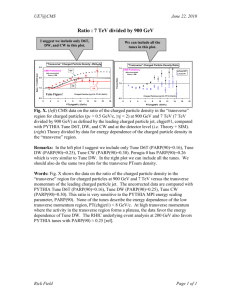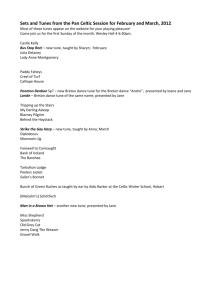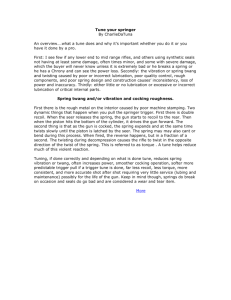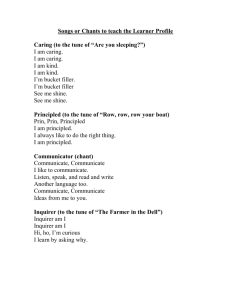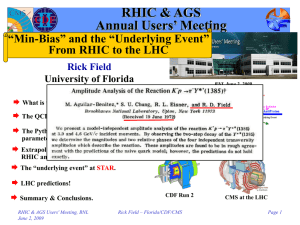Toward an Understanding of Hadron-Hadron Collisions From Feynman-Field to the LHC Rick Field
advertisement
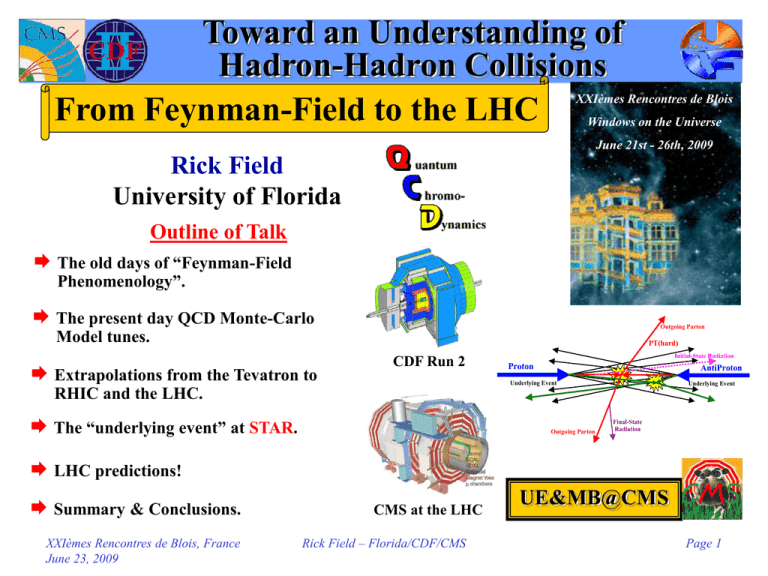
Toward an Understanding of Hadron-Hadron Collisions From Feynman-Field to the LHC XXIèmes Rencontres de Blois Windows on the Universe June 21st - 26th, 2009 Rick Field University of Florida Outline of Talk The old days of “Feynman-Field Phenomenology”. The present day QCD Monte-Carlo Outgoing Parton Model tunes. PT(hard) Extrapolations from the Tevatron to CDF Run 2 Initial-State Radiation Proton AntiProton Underlying Event Underlying Event RHIC and the LHC. The “underlying event” at STAR. Outgoing Parton Final-State Radiation LHC predictions! Summary & Conclusions. XXIèmes Rencontres de Blois, France June 23, 2009 CMS at the LHC Rick Field – Florida/CDF/CMS UE&MB@CMS Page 1 Hadron-Hadron Collisions FF1 1977 What happens when two hadrons collide at high energy? Hadron Hadron Feynman quote from FF1 ??? “The model we shall choose is not a popular one, Most of the time the hadrons ooze so that we will not duplicate too much of the through each other andwork fall apart (i.e.who are similarly analyzing of others no hard scattering). The outgoing various models (e.g. constituent interchange particles continue in roughly the same model, multiperipheral models, etc.). We shall Parton-Parton Scattering Outgoing Parton assume direction as initial proton andthat the high PT particles arise from “Soft” constituent Collision (no large transverse momentum) direct hard collisions between antiproton. quarks in the incoming particles, which Hadron Hadron Occasionally there will be a large fragment or cascade down into several hadrons.” transverse momentum meson. Question: Where did it come from? We assumed it came from quark-quark elastic scattering, but we did not know how to calculate it! Outgoing Parton high PT meson “Black-Box Model” XXIèmes Rencontres de Blois, France June 23, 2009 Rick Field – Florida/CDF/CMS Page 3 Quark-Quark Black-Box Model No gluons! Quark Distribution Functions determined from deep-inelastic lepton-hadron collisions FF1 1977 Feynman quote from FF1 “Because of the incomplete knowledge of our functions some things can be predicted with more certainty than others. Those experimental results that are not well predicted can be “used up” to determine these functions in greater detail to permit better predictions of further experiments. Our papers will be a bit long because we wish to discuss this interplay in detail.” Quark-Quark Cross-Section Unknown! Deteremined from hadron-hadron collisions. XXIèmes Rencontres de Blois, France June 23, 2009 Rick Field – Florida/CDF/CMS Quark Fragmentation Functions determined from e+e- annihilations Page 4 Quark-Quark Black-Box Model Predict particle ratios FF1 1977 Predict increase with increasing CM energy W When Jim Cronin’s group at the University of Chicago measured these rations and we knew we were on the right track! The “underlying event” (Beam-Beam Remnants)! Predict overall event topology (FFF1 paper 1977) 7 GeV/c p0’s! XXIèmes Rencontres de Blois, France June 23, 2009 Rick Field – Florida/CDF/CMS Page 5 QCD Approach: Quarks & Gluons Quark & Gluon Fragmentation Functions Q2 dependence predicted from QCD Parton Distribution Functions Q2 dependence predicted from QCD FFF2 1978 Feynman quote from FFF2 “We investigate whether the present experimental behavior of mesons with large transverse momentum in hadron-hadron collisions is consistent with the theory of quantum-chromodynamics (QCD) with asymptotic freedom, at least as the theory is now partially understood.” Quark & Gluon Cross-Sections Calculated from QCD XXIèmes Rencontres de Blois, France June 23, 2009 Rick Field – Florida/CDF/CMS Page 6 High PT Jets CDF (2006) Feynman, Field, & Fox (1978) Predict large “jet” cross-section 30 GeV/c! Feynman quote from FFF 600writing, GeV/c Jets! “At the time of this there is still no sharp quantitative test of QCD. An important test will come in connection with the phenomena of high PT discussed here.” XXIèmes Rencontres de Blois, France June 23, 2009 Rick Field – Florida/CDF/CMS Page 7 QCD Monte-Carlo Models: High Transverse Momentum Jets Hard Scattering Initial-State Radiation Hard Scattering “Jet” Initial-State Radiation “Jet” Outgoing Parton PT(hard) Outgoing Parton PT(hard) Proton “Hard Scattering” Component AntiProton Final-State Radiation Outgoing Parton Underlying Event Underlying Event Proton “Jet” Final-State Radiation AntiProton Underlying Event Outgoing Parton Underlying Event “Underlying Event” Start with the perturbative 2-to-2 (or sometimes 2-to-3) parton-parton scattering and add initial and finalstate gluon radiation (in the leading log approximation or modified leading log approximation). The “underlying event” consists of the “beam-beam remnants” and from particles arising from soft or semi-soft multiple parton interactions (MPI). The “underlying event” is“jet” an unavoidable Of course the outgoing colored partons fragment into hadron and inevitably “underlying event” background to most collider observables observables receive contributions from initial and final-state radiation. and having good understand of it leads to more precise collider measurements! XXIèmes Rencontres de Blois, France June 23, 2009 Rick Field – Florida/CDF/CMS Page 8 CDF Run 1: Evolution of Charged Jets “Underlying Event” Charged Particle Correlations PT > 0.5 GeV/c |h| < 1 Charged Jet #1 Direction “Transverse” region very sensitive to the “underlying event”! Look at the charged particle density in the “transverse” region! 2p “Toward-Side” Jet “Toward” CDF Run 1 Analysis Away Region Charged Jet #1 Direction Transverse Region “Toward” “Transverse” Leading Jet “Transverse” Toward Region “Transverse” “Transverse” Transverse Region “Away” “Away” Away Region “Away-Side” Jet 0 -1 h +1 Look at charged particle correlations in the azimuthal angle relative to the leading charged particle jet. Define || < 60o as “Toward”, 60o < || < 120o as “Transverse”, and || > 120o as “Away”. All three regions have the same size in h- space, hx = 2x120o = 4p/3. XXIèmes Rencontres de Blois, France June 23, 2009 Rick Field – Florida/CDF/CMS Page 10 PYTHIA 6.206 Defaults MPI constant probability scattering PYTHIA default parameters 6.115 6.125 6.158 6.206 MSTP(81) 1 1 1 1 MSTP(82) 1 1 1 1 PARP(81) 1.4 1.9 1.9 1.9 PARP(82) 1.55 2.1 2.1 1.9 PARP(89) 1,000 1,000 1,000 PARP(90) 0.16 0.16 0.16 4.0 1.0 1.0 PARP(67) 4.0 1.00 "Transverse" Charged Density Parameter "Transverse" Charged Particle Density: dN/dhd CDF Data Pythia 6.206 (default) MSTP(82)=1 PARP(81) = 1.9 GeV/c data uncorrected theory corrected 0.75 0.50 0.25 1.8 TeV |h|<1.0 PT>0.5 GeV 0.00 0 5 10 15 20 25 30 35 40 45 50 PT(charged jet#1) (GeV/c) CTEQ3L CTEQ4L CTEQ5L CDF Min-Bias CDF JET20 Plot shows the “Transverse” charged particle density versus PT(chgjet#1) compared to the QCD hard scattering predictions of PYTHIA 6.206 (PT(hard) > 0) using the default parameters for multiple parton interactions and CTEQ3L, CTEQ4L, and CTEQ5L. Note Change PARP(67) = 4.0 (< 6.138) PARP(67) = 1.0 (> 6.138) XXIèmes Rencontres de Blois, France June 23, 2009 Default parameters give very poor description of the “underlying event”! Rick Field – Florida/CDF/CMS Page 11 Tuning PYTHIA: Multiple Parton Interaction Parameters Parameter Default PARP(83) 0.5 Double-Gaussian: Fraction of total hadronic matter within PARP(84) PARP(84) 0.2 Double-Gaussian: Fraction of the overall hadron radius containing the fraction PARP(83) of the total hadronic matter. Determines the energy Probability that of thethe MPI produces two gluons dependence MPI! with color connections to the “nearest neighbors. 0.33 PARP(86) 0.66 PARP(89) PARP(82) PARP(90) PARP(67) 1 TeV 1.9 GeV/c 0.16 1.0 Multiple Parton Interaction Color String Color String Multiple PartonDetermine Interactionby comparing Probability thatAffects the MPI theproduces amount two of gluons either as described by PARP(85) or as a closed initial-state radiation! gluon loop. The remaining fraction consists of quark-antiquark pairs. with 630 GeV data! Color String Hard-Scattering Cut-Off PT0 Determines the reference energy E0. The cut-off PT0 that regulates the 2-to-2 scattering divergence 1/PT4→1/(PT2+PT02)2 Determines the energy dependence of the cut-off PT0 as follows PT0(Ecm) = PT0(Ecm/E0)e with e = PARP(90) A scale factor that determines the maximum parton virtuality for space-like showers. The larger the value of PARP(67) the more initialstate radiation. XXIèmes Rencontres de Blois, France June 23, 2009 Rick Field – Florida/CDF/CMS 5 PYTHIA 6.206 e = 0.25 (Set A)) 4 PT0 (GeV/c) PARP(85) Description Take E0 = 1.8 TeV 3 2 e = 0.16 (default) 1 100 1,000 10,000 100,000 CM Energy W (GeV) Reference point at 1.8 TeV Page 12 Run 1 PYTHIA Tune A CDF Default! PYTHIA 6.206 CTEQ5L "Transverse" Charged Particle Density: dN/dhd Parameter Tune B Tune A MSTP(81) 1 1 MSTP(82) 4 4 PARP(82) 1.9 GeV 2.0 GeV PARP(83) 0.5 0.5 PARP(84) 0.4 0.4 PARP(85) 1.0 0.9 "Transverse" Charged Density 1.00 CDF Preliminary 0.75 1.0 0.95 PARP(89) 1.8 TeV 1.8 TeV PARP(90) 0.25 0.25 PARP(67) 1.0 4.0 Not the default! New PYTHIA default (less initial-state radiation) XXIèmes Rencontres de Blois, France June 23, 2009 Run 1 Analysis 0.50 0.25 CTEQ5L PYTHIA 6.206 (Set B) PARP(67)=1 1.8 TeV |h|<1.0 PT>0.5 GeV 0.00 0 PARP(86) PYTHIA 6.206 (Set A) PARP(67)=4 data uncorrected theory corrected 5 10 15 20 25 30 35 40 45 50 PT(charged jet#1) (GeV/c) Plot shows the “transverse” charged particle density versus PT(chgjet#1) compared to the QCD hard scattering predictions of two tuned versions of PYTHIA 6.206 (CTEQ5L, Set B (PARP(67)=1) and Set A (PARP(67)=4)). Old PYTHIA default (more initial-state radiation) Rick Field – Florida/CDF/CMS Page 13 “Transverse” Charged Density PTmax Direction "Transverse" Charged Particle Density: dN/dhd 0.8 “Transverse” “Transverse” “Away” ChgJet#1 Direction “Toward” “Transverse” “Transverse” “Away” "Transverse" Charged Density “Toward” RDF Preliminary 1.96 TeV py Tune A generator level 0.6 0.6 0.4 Jet#1 ChgJet#1 0.2 PTmax Charged Particles (|h|<1.0, PT>0.5 GeV/c) 0.0 Jet#1 Direction 0 5 10 15 20 25 30 PT(jet#1) or PT(chgjet#1) or PTmax (GeV/c) “Toward” “Transverse” “Transverse” “Away” Shows the charged particle density in the “transverse” region for charged particles (pT > 0.5 GeV/c, |h| < 1) at 1.96 TeV as defined by PTmax, PT(chgjet#1), and PT(jet#1) from PYTHIA Tune A at the particle level (i.e. generator level). XXIèmes Rencontres de Blois, France June 23, 2009 Rick Field – Florida/CDF/CMS Page 14 All use LO as with L = 192 MeV! UE Parameters ISR Parameter PYTHIA 6.2 Tunes Parameter Tune AW Tune DW Tune D6 PDF CTEQ5L CTEQ5L CTEQ6L MSTP(81) 1 1 1 MSTP(82) 4 4 4 PARP(82) 2.0 GeV 1.9 GeV 1.8 GeV PARP(83) 0.5 0.5 0.5 PARP(84) 0.4 0.4 0.4 PARP(85) 0.9 1.0 1.0 PARP(86) 0.95 1.0 1.0 PARP(89) 1.8 TeV 1.8 TeV 1.8 TeV PARP(90) 0.25 0.25 0.25 PARP(62) 1.25 1.25 1.25 PARP(64) 0.2 0.2 0.2 PARP(67) 4.0 2.5 2.5 MSTP(91) 1 1 1 PARP(91) 2.1 2.1 2.1 PARP(93) 15.0 15.0 15.0 Uses CTEQ6L Tune A energy dependence! (not the default) Intrinsic KT XXIèmes Rencontres de Blois, France June 23, 2009 Rick Field – Florida/CDF/CMS Page 15 All use LO as with L = 192 MeV! UE Parameters Tune A ISR Parameter PYTHIA 6.2 Tunes Parameter Tune DWT Tune D6T ATLAS PDF CTEQ5L CTEQ6L CTEQ5L MSTP(81) 1 1 1 MSTP(82) 4 4 4 PARP(82) 1.9409 GeV 1.8387 GeV 1.8 GeV PARP(83) 0.5 0.5 0.5 0.4 0.4 0.5 PARP(67) 2.5 2.5 1.0 MSTP(91) 1 1 1 PARP(91) Tune D ATLAS energy dependence! (PYTHIA default) Tune B Tune AW PARP(85) 1.0 0.33 tunes! These are 1.0 “old” PYTHIA 6.2 PARP(86) 1.0 0.66 There 1.0 are new 6.420 tunes by Tune BW PARP(89) 1.96 TeV 1.96 TeV 1.0 TeV Peter Skands (Tune S320, update of S0) PARP(90) 0.16 0.16 0.16 Peter Skands (Tune N324, N0CR) PARP(62) 1.25 1.25 1.0 Hendrik Hoeth (Tune0.2P329, “Professor”) PARP(64) 0.2 1.0 PARP(84) PARP(93) Tune 2.1 DW 15.0 2.1 15.0 5.0 Tune D6T Intrinsic KT XXIèmes Rencontres de Blois, France June 23, 2009 1.0 Tune D6 Rick Field – Florida/CDF/CMS Page 16 Min-Bias “Associated” Charged Particle Density 35% more at RHIC means "Transverse" Charged Particle Density: dN/dhd 26% less at the LHC! 1.6 RDF Preliminary "Transverse" Charged Density 0.3 "Transverse" Charged Density "Transverse" Charged Particle Density: dN/dhd PY Tune DW generator level 0.2 ~1.35 PY Tune DWT 0.1 Min-Bias 0.2 TeV Charged Particles (|h|<1.0, PT>0.5 GeV/c) RDF Preliminary PY Tune DWT generator level 1.2 ~1.35 0.8 PY Tune DW 0.4 Min-Bias 14 TeV Charged Particles (|h|<1.0, PT>0.5 GeV/c) 0.0 0.0 0 2 4 6 8 10 12 14 16 18 20 0 2 4 6 8 PTmax Direction “Toward” “Transverse” 12 14 16 18 20 PTmax (GeV/c) PTmax (GeV/c) RHIC 10 PTmax Direction 0.2 TeV → 14 TeV (~factor of 70 increase) “Transverse” “Away” “Toward” LHC “Transverse” “Transverse” “Away” Shows the “associated” charged particle density in the “transverse” regions as a function of PTmax for charged particles (pT > 0.5 GeV/c, |h| < 1, not including PTmax) for “min-bias” events at 0.2 TeV and 14 TeV from PYTHIA Tune DW and Tune DWT at the particle level (i.e. generator level). The STAR data from RHIC favors Tune DW! XXIèmes Rencontres de Blois, France June 23, 2009 Rick Field – Florida/CDF/CMS Page 17 Min-Bias “Associated” Charged Particle Density "Transverse" Charged Particle Density: dN/dhd "Transverse" Charged Density 1.2 RDF Preliminary 14 TeV Min-Bias py Tune DW generator level 0.8 ~1.9 0.4 1.96 TeV ~2.7 0.2 TeV Charged Particles (|h|<1.0, PT>0.5 GeV/c) 0.0 0 5 10 15 20 25 PTmax (GeV/c) PTmax Direction “Toward” RHIC “Transverse” “Transverse” 0.2 TeV → 1.96 TeV (UE increase ~2.7 times) Tevatron “Away” PTmax Direction “Toward” “Transverse” PTmax Direction 1.96 TeV → 14 TeV (UE increase ~1.9 times) LHC “Transverse” “Away” “Toward” “Transverse” “Transverse” “Away” Shows the “associated” charged particle density in the “transverse” region as a function of PTmax for charged particles (pT > 0.5 GeV/c, |h| < 1, not including PTmax) for “min-bias” events at 0.2 TeV, 1.96 TeV and 14 TeV predicted by PYTHIA Tune DW at the particle level (i.e. generator level). XXIèmes Rencontres de Blois, France June 23, 2009 Rick Field – Florida/CDF/CMS Page 18 The “Underlying Event” at STAR At STAR they have measured the “underlying event at W = 200 GeV (|h| < 1, pT > 0.2 GeV) and compared their uncorrected data with PYTHIA Tune A + STAR-SIM. XXIèmes Rencontres de Blois, France June 23, 2009 Rick Field – Florida/CDF/CMS Page 19 Min-Bias “Associated” Charged Particle Density RDF LHC Prediction! "Transverse" Charged Particle Density: dN/dhd "Transverse" Charged Particle Density: dN/dhd 1.6 RDF Preliminary PY64 Tune P329 "Transverse" Charged Density "Transverse" Charged Density 0.8 generator level 0.6 0.4 PY Tune A PY64 Tune N324 0.2 PY64 Tune S320 Min-Bias 1.96 TeV Charged Particles (|h|<1.0, PT>0.5 GeV/c) 0.0 PY ATLAS RDF Preliminary PY Tune DWT generator level 1.2 0.8 PY64 Tune P329 PY Tune A 0.4 PY Tune DW PY64 Tune S320 Min-Bias 14 TeV Charged Particles (|h|<1.0, PT>0.5 GeV/c) If the LHC data are not in the range shown here then we learn new (QCD) physics! 0.0 0 2 4 6 8 10 12 14 16 18 20 0 5 10 PTmax (GeV/c) PTmax Direction “Transverse” 20 25 PTmax Direction “Toward” “Toward” “Transverse” 15 PTmax (GeV/c) Tevatron LHC “Transverse” “Transverse” “Away” “Away” Shows the “associated” charged particle density in the “transverse” region as a function of PTmax for charged particles (pT > 0.5 GeV/c, |h| < 1, not including PTmax) for “min-bias” events at 1.96 TeV from PYTHIA Tune A, Tune S320, Tune N324, and Tune P329 at the particle level (i.e. generator level). Extrapolations of PYTHIA Tune A, Tune DW, Tune DWT, Tune S320, Tune P329, and pyATLAS to the LHC. XXIèmes Rencontres de Blois, France June 23, 2009 Rick Field – Florida/CDF/CMS Page 20 Charged Particle Density: dN/dh RDF LHC Prediction! Charged Particle Density: dN/dh Charged Particle Density: dN/dh 5.0 8.0 Charged Particle Density Charged Particle Density PY Tune A RDF Preliminary generator level 4.0 3.0 PY Tune DW 2.0 PY64 Tune S320 PY64 Tune P329 1.0 Min-Bias 1.96 TeV Charged Particles (all PT) 0.0 PY64 Tune P329 RDF Preliminary generator level PY Tune DWT 6.0 PY ATLAS 4.0 PY Tune DW PY Tune A PY64 Tune S320 2.0 If the LHC data are not in the range shown here then we learn new (QCD) physics! 0.0 -8 -6 -4 -2 0 2 4 6 8 -8 -6 -4 -2 PseudoRapidity h “Minumum Bias” Collisions Proton Min-Bias 14 TeV Charged Particles (all PT) 2 4 6 PseudoRapidity h AntiProton Tevatron 0 Proton “Minumum Bias” Collisions Proton LHC Charged particle (all pT) pseudo-rapidity distribution, dNchg/dhd, at 1.96 TeV for inelastic non-diffractive collisions from PYTHIA Tune A, Tune DW, Tune S320, and Tune P324. Extrapolations (all pT) of PYTHIA Tune A, Tune DW, Tune S320, Tune P324. and ATLAS to the LHC. XXIèmes Rencontres de Blois, France June 23, 2009 Rick Field – Florida/CDF/CMS Page 22 8 Summary & Conclusions However, I believe that the better fits to the LEP fragmentation data at high z will lead to small improvements Outgoing Parton of Tune A at the Tevatron! We are making good progress in understanding and modeling the “underlying event”. RHIC data at 200 GeV are very important! PT(hard) Initial-State Radiation Proton The new Pythia pT ordered tunes (py64 S320 and py64 P329) are very similar to Tune A, Tune AW, and Tune DW. At present the new tunes do not fit the data better than Tune AW and Tune DW. However, the new tune are theoretically preferred! AntiProton Underlying Event Underlying Event Outgoing Parton Final-State Radiation Hard-Scattering Cut-Off PT0 PYTHIA 6.206 e = 0.25 (Set A)) 4 PT0 (GeV/c) It is clear now that the default value PARP(90) = 0.16 is not correct and the value should be closer to the Tune A value of 0.25. The new and old PYTHIA tunes are beginning to converge and I believe we are finally in a position to make some legitimate predictions at the LHC! 5 3 2 e = 0.16 (default) 1 All tunes with the default value PARP(90) = 0.16 are wrong and are overestimating the activity of min-bias and the underlying event at the LHC! This includes all my “T” tunes and the ATLAS tunes! Need to measure “Min-Bias” and the “underlying event” at the LHC as soon as possible to see if there is new QCD physics to be learned! XXIèmes Rencontres de Blois, France June 23, 2009 Rick Field – Florida/CDF/CMS 100 1,000 10,000 100,000 CM Energy W (GeV) UE&MB@CMS Page 23
